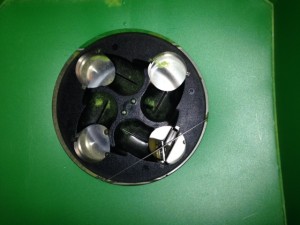Ball Jams
 After rainy weather we notice an increased volume of calls about tennis balls jamming in ball machines. Wet tennis balls are usually the culprit, as wet balls cause ball jams. We would like to help first-time ball machine owners prevent ball jams. By taking a few of the following steps, ball jams can be kept to a minimum or completely eliminated. Of course the easiest way to avoid ball jams is to avoid using the ball machine when the court is wet. Water from the wet court is absorbed by the tennis balls. When the tennis balls are returned to the hopper of the ball machine they take all of that water with them into the moving parts of the machine.
After rainy weather we notice an increased volume of calls about tennis balls jamming in ball machines. Wet tennis balls are usually the culprit, as wet balls cause ball jams. We would like to help first-time ball machine owners prevent ball jams. By taking a few of the following steps, ball jams can be kept to a minimum or completely eliminated. Of course the easiest way to avoid ball jams is to avoid using the ball machine when the court is wet. Water from the wet court is absorbed by the tennis balls. When the tennis balls are returned to the hopper of the ball machine they take all of that water with them into the moving parts of the machine.
The feed tray is the black disk with four holes. You can see it in the bottom of the hopper. (see photos below) The pitching wheels are two urethane wheels which spin very fast in opposite direction to throw the ball. The pitching wheels are designed to grip the tennis ball, compress it, and throw it. Although the urethane wheel is tacky, it cannot grip wet balls, and so the ball slips, gets stuck, and jiggles between the feed tray and the pitching wheels.
Normally the tennis balls fall through the feed tray, into the pitching wheels and are thrown out of the machine. Sometimes a ball can get compressed and wedged beneath the feed tray. This can be caused by a “dead ball”, a tennis ball that has lost its compression and it flat or squishy. When this occurs, the ball can be removed easily by removing the feed tray. To remove the feed tray, first take all the balls out of the hopper. Once the feed tray is exposed, use a Phillips screwdriver to remove the two screws in the center of the feed tray, careful to retain the lock washers. The feed tray will come off and the balls can be removed. There may be multiple balls in the space beneath the feed tray and resting above the pitching wheels. With your hand, reach inside the ball machine (with the machine turned off and unplugged) and roll the upper pitching wheel towards you to move jammed balls back up and out of the hopper. After all balls are removed, replace the feed tray by returning the two screws back into place.
The feed wire is a metal wire that prevents multiple balls from passing through the feed tray. If the feed wire becomes bent, then balls stack-up in the feed mechanism, and ball jams can occur.
Here is a photo of a bent feed wire. You can see that the feed wire is not above the center of the feed tray hole. It is bent away from the hole. This allows multiple balls to pass through the feed tray. You can see that one of these balls got stuck beneath the feed tray. This will have to be removed by taking out the two Phillips screws and temporarily removing the tray.
If the feed wire becomes bent we can replace it or in some cases it can be bent back into place.
Ball jams are avoidable. Remember to use dry balls that have some pressure left in them. Its OK to use older tennis balls, as long as they are not completely “dead”. Consider using few balls of better quality. Some users don’t fill the hopper to capacity. They may use less than 70 balls in the machine. This makes it easier to maintain a consistent batch of balls for use in the ball machine. If you live in a humid area, it is possible condensation can form on the balls in the hopper while the machine is stored overnight. If the ball machine is not used for long periods of time during the winter, remove the balls and store them separately. Many of our ball machine customers keep their machine in a shed. Rubbermaid makes small sheds which can be built directly on the tennis court. Vinyl covers are available from DH Distribution. For more information about sales or service of Playmate Tennis Ball Machines feel free to contact us.

 VIEW CART
VIEW CART

